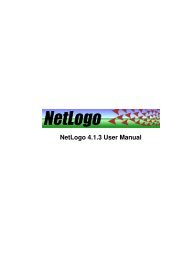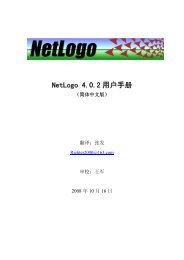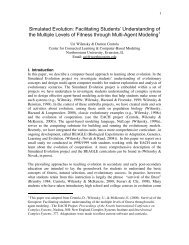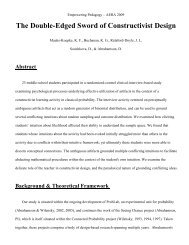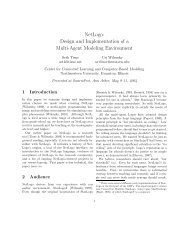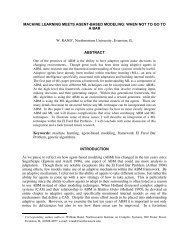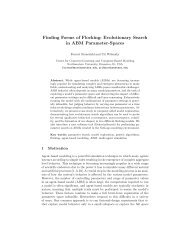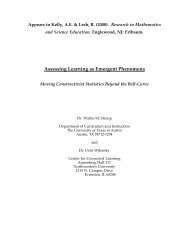Design Guidelines for Agent Based Model Visualization
Design Guidelines for Agent Based Model Visualization
Design Guidelines for Agent Based Model Visualization
Create successful ePaper yourself
Turn your PDF publications into a flip-book with our unique Google optimized e-Paper software.
<strong>Design</strong> <strong>Guidelines</strong> <strong>for</strong> <strong>Agent</strong> <strong>Based</strong> <strong>Model</strong> <strong>Visualization</strong><br />
4.2<br />
4.3<br />
4.4<br />
4.5<br />
4.6<br />
4.7<br />
There are now several ABM toolkits available. It is impractical to categorize all of the ABM<br />
visualizations of every model in each ABM toolkit, and there<strong>for</strong>e we have chosen to examine the<br />
NetLogo models library. <strong>Based</strong> on this extensive library (over 200 models) the authors have<br />
developed a set of distinct tags (see Figure 2-a 2-b 2-c). Our approach was inspired by (Lohse, 1994)<br />
who classified static visualizations but we did not use external subjects to per<strong>for</strong>m the classification.<br />
We clustered screenshots of similar visualizations displayed in the NetLogo Samples <strong>Model</strong> Library.<br />
However, on some occasions if the screenshot did not clearly demarcate a category, we ran the model<br />
in NetLogo to observe the model's behavior. Due to the open-ended design of ABM visualizations we<br />
find it is impractical to try to classify them using a rigid taxonomy, there<strong>for</strong>e we created an ad-hoc<br />
non-hierarchical classification. The sole purpose of these classification tags is to orient the novice to<br />
the possibilities and limitations of ABM visualizations.<br />
Labeling the NetLogo <strong>Model</strong>s Library has several advantages. First, the visualizations are intrinsically<br />
driven by agents since NetLogo models are constructed with data structures and primitives implicitly<br />
imbued with ABM semantics. Moreover, NetLogo visualizations share the same graphical and<br />
programmatic primitives; thus they can be compared and analyzed using the same criteria. Finally, the<br />
NetLogo <strong>Model</strong>s Library goes through a strict checkout process assuring that the models have<br />
sufficient quality and accuracy to be deployed <strong>for</strong> use in educational institutions.<br />
This classification could be improved substantially, particularly by asking external subjects to tag the<br />
images and by using dynamic NetLogo animations instead of static images from the screenshots.<br />
However, we consider this first classification suitable <strong>for</strong> our purposes, namely, assisting the novice in<br />
locating a visualization category to initially guide his or her model's visualization design.<br />
The classification of models is purely visual. It does not take into account the particular phenomenon<br />
being explored by the model. In other words, we did not consider the subject area or discipline of the<br />
model. Of course, some visualizations in the same category share the same type of phenomenon, but it<br />
is not unusual to find unrelated phenomena appearing in the same category. This classification is not<br />
meant to be a rigid comprehensive classification; on the contrary, it is meant to be an easily<br />
understandable and flexible overview. Thus, the modeler should envision the model that they<br />
eventually want to develop and then examine categories below based on that conception, to find a<br />
starting point <strong>for</strong> the design of their new visualization.<br />
We divide ABM visualizations into three main categories: conventional, unstructured and structured.<br />
Conventional visualizations make use of previously established representations while unstructured<br />
visualizations display abstract or irregular patterns, and structured visualizations convey meaning<br />
through shape or regular patterns. These categories should not be conceived of as mutually exclusive.<br />
Indeed, visualizations can encompass several categories and can even switch categories depending on<br />
the state of the simulation. Many tags can describe one model, and the same tag can be used to<br />
describe many models. We created categories that convey a certain sense of the potential of ABM<br />
graphics to the novice.<br />
Conventional ABM visualizations encompass established representations of mathematical and/or<br />
natural phenomena. The viewer understands these representations since he has seen or studied similar<br />
representations previously. This exposure may have taken place in several contexts such as an<br />
educational institution or popular culture. For instance, in recent years fractals have entered<br />
educational institutions and mainstream culture -- thus an educated audience can now understand the<br />
context and relevance of a fractal in a visualization when previously they would have been unable to<br />
comprehend the representation.<br />
We divided the rest of ABM visualizations into two categories: structured ABM visualizations and<br />
unstructured ABM visualizations. Note that this is not a rigid categorization; an unstructured ABM<br />
visualization can become a structured ABM visualization through emergent behavior. These<br />
http://jasss.soc.surrey.ac.uk/12/2/1.html<br />
11/20/09 3:30 PM<br />
Page 5 of 32



